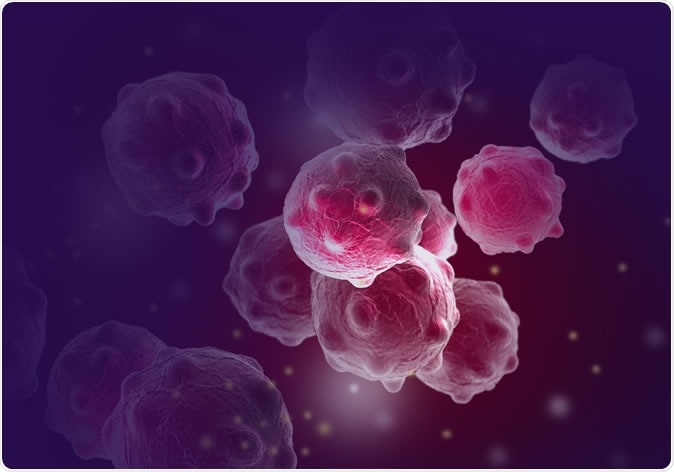A study published in the journal Proceedings of the National Academy of Sciences reports on a novel type of scanning which uses magnetized molecules to visualize active areas within a breast tumor specifically. This marks the first successful attempt to demonstrate the role of this type of scanning in the field of breast cancer monitoring.
Breast cancer is the most common type of cancer in the UK, with about 55,000 new cases annually. About 80% overall do survive for at least 10 years from the diagnosis. The prognosis for certain subtypes is much worse, however. This is where it would be very effective to have information about the tumor and the metabolism within the cancer, so as to tailor the treatment to the tumor.

Digital 3d illustration of cancer cells. Image Credit: Jovan Vitanovski / Shutterstock
Carbon-13 hyperpolarized imaging
The imaging technique called carbon-13 hyperpolarized imaging was tested in this study.
yperpolarized carbon-13 pyruvate is a chemical composed of a heavier isotope of carbon in the form of the chemical compound pyruvate. Pyruvate in this form is thus labelled with carbon-13. Pyruvate is formed when glucose and other sugars are broken down for energy in the human body.
The scientists cooled carbon-13 pyruvate to just about one degree above -273 0 C, which is just one degree above absolute zero at which all molecular motion stops. At this temperature the carbon-13 pyruvate was magnetized by a very strong magnetic field and microwave radiation. After this, the frozen pyruvate was thawed and made to dissolve into a solution.
The solution of carbon-13 pyruvate was then injected into the seven patients. Following the injection, they were scanned using a magnetic resonance imaging (MRI) device. However, the use of the magnetized tracer caused the signal being emitted by the tumor to increase ten thousand times. This was so intense that it appeared on the scan. This was immediately converted into the rate of conversion of pyruvate into lactate in the body.
This step is essential to enter the metabolic pathway to produce energy and also to synthesize new material used to build the cells of the body themselves. Since cancer cells multiply much faster they produce lactate at a higher rate, the exact reading being slightly different in different areas of the same tumor and between different tumors.
The scans were taken at baseline, before the onset of any treatment. The scan was conducted in order to assess the rate at which the tumor cells were using a molecule called pyruvate.
The findings
The hyperpolarized Carbon-13 imaging showed how fast pyruvate was broken down, and thus revealed the differences in tumor size, shape and grade, which in turn indicates the aggressiveness of the tumor.
The scan also showed the physical features of the cancer and thus showed how different parts of the same tumor acted differently as a result of variations in the metabolism. The specificity and minuteness of the picture is described by researcher Kevin Brindle: “This is one of the most detailed pictures of the metabolism of a patient's breast cancer that we've ever been able to achieve. It's like we can see the tumour 'breathing'.”
Implications
This real-time monitoring could help greatly with defining the type and the aggressiveness of the cancer. If validated the technique should be applied to larger groups as this will allow the observers to see how it can be used to decide on the right treatment for patients in hospitals.
Combining this with advances in genetic testing, this scan could in the future allow doctors to better tailor treatments to each individual, and detect whether patients are responding to treatments, like chemotherapy, earlier than is currently possible.” Researcher Charles Swanton points out that it is a simple and non-invasive test, lending itself to as frequent repetition as necessary, to determine if the treatment is effective or not. He says, “Ultimately, the hope is that scans like this could help doctors decide to switch to a more intensive treatment if needed, or even reduce the treatment dose, sparing people unnecessary side effects".